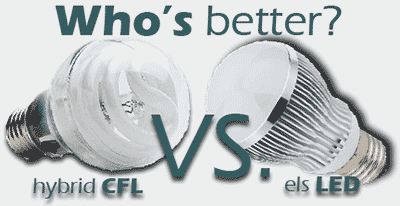
GE Hybrid CFL vs. ELS LED Lamp- Who's Better?
General Electric lighting’s latest customer-inspired light bulb—a hybrid halogen-CFL contained in an incandescent-shaped glass bulb—hits the target for homeowners who love the energy efficiency and long life of GE-quality CFLs but have yearned for more immediate brightness in an energy-saving bulb. GE Energy Smart® Soft White and Reveal® hybrid halogen-CFL bulbs will brighten the lighting aisles of mass retail, hardware and big box stores nationwide in the weeks leading up to Earth Day 2011 (April 22). With the emergence of LED technology, I wanted to compare and contrast GE's latest offering vs. Electronic Lighting Science's (ELS) LED bulb.
General Electric's new hybrid-halogen CFL combines attributes of three popular lighting technologies. GE engineers figured out a way to nestle an instantly bright halogen capsule inside the swirl of a compact fluorescent light bulb. The halogen element comes on instantly and turns off once the CFL comes to full brightness, thus preserving the energy efficiency of the bulb. All the workings of the bulb are contained in an incandescent-shaped glass bulb. “It looks like an incandescent in size and shape but it’s really three bulbs in one,” observes Kristin Gibbs, general manager of consumer marketing, GE Lighting. “The instant brightness factor makes our new hybrid halogen-CFL more versatile than other CFLs. It’s an optimal choice for use in hallways, stairways, kitchens, bathrooms and anywhere immediate brightness is essential. Simply flip that light switch and it’s at your service—immediately.”
These new GE CFLs offer eight times the life of incandescent bulbs (8,000 hours vs. 1,000 hours). The new products—RoHS-compliant 15- and 20-watt GE Energy Smart® Soft White (2700 Kelvin) and Reveal® (2500 Kelvin) CFLs with exceptionally low levels of mercury (1 mg) can replace standard 60- and 75-watt incandescent bulbs or other CFLs that don’t offer a satisfactory quality of light or instant brightness. Currently available CFLs contain 1.5 mg to 3.5 mg of mercury.
The LED bulb by Electronic Lighting Science has instant on capability, which is naturally inherent with LED technology. The ELS bulb only consumes 5 watts of energy, as compared to 15 and 20 watts, respectively with the GE CFL. This represents a 66 to 75% reduction in energy over its competitor. The ELS bulb maintains the efficacy and dimensions of a traditional incandescent light bulb. A great benefit that the LED bulb offers, compared to incandescent, halogen, and compact fluorescent, is that the bulb is a cool lighting source, which won't press your HVAC systems. The ELS LED lamp has a life span of 20,000 hours, which is 2.5 times longer than the GE CFL. There is no mercury contained in ELS LED lamps.
Retailers set prices but customers could expect to pay $5.99-$9.99 based on product line and wattage. The ELS 5 watt bulb's wholesale price is sub $20.00 USD, which is far less than competing LED bulbs in the market.
So who's better? You may have to decide. The upfront cost of the GE lamp is less than the competing LED bulb. Based on a 20,000 hour life span, the cost of purchasing 2.5 CFLs, and the cost of energy at $0.10/kWh, the CFL bulb will cost you roughly $55.00. Based upon the same variables for the LED bulb, the LED bulb will cost you roughly $35.00 over that same life span. The GE lamp has a greater spherical lighting surface than the LED bulb, which increases that lighting applications that can be used with the light. The LED lamp has no hazardous waste, unlike its CFL competitor. If dollars make sense, my dollars suggest the LED offering.
For more information on the ELS LED lamp Click Here.
|
|
A bright idea: CFL, halogen and LED bulbs will save you money in the long run
By Gregory Karp
McClatchy News Service
How many tips does it take to change a light bulb?
A few more, apparently.
Despite avid media coverage and education campaigns by the U.S. government and environmental groups, consumers still aren't flocking to newer, energy-efficient light bulbs.
Even in states with long-running and well-funded programs to promote compact fluorescent lamps, only 1 in 5 household sockets contain those bulbs, according to a report by the U.S. Department of Energy.
Sales of CFLs peaked in 2007 and have declined since, the report says.
But a switch could be good for your wallet. And besides, you won't have much choice soon.
A federal law passed in 2007 requires manufacturers to make light bulbs that emit the same brightness using less energy.
Traditional incandescent bulbs can't do that, so they'll effectively be dropped from production over the next few years. As a consumer, you can continue using incandescents, but eventually you won't be able to buy any more unless it's a specialty bulb.
A phase-in of the new rules starts next January with 100-watt bulbs. That's news to a lot of people. Just two in 10 people know about the 100-watt bulb's impending extinction, according to a recent survey by lighting manufacturer Osram Sylvania.
Some consumers aware of the coming change — 13 percent — plan to stock up on incandescent 100-watt bulbs while they can get them, the survey found. A Consumer Reports blog referred to them as "Lightbulb Luddites."
That's probably because consumers have a better alternative to hoarding inefficient 100-watters. That is, switching to new energy-efficient bulbs, probably CFLs and perhaps halogen incandescents or light-emitting diodes (LEDs), experts say. Read More>>>
|

